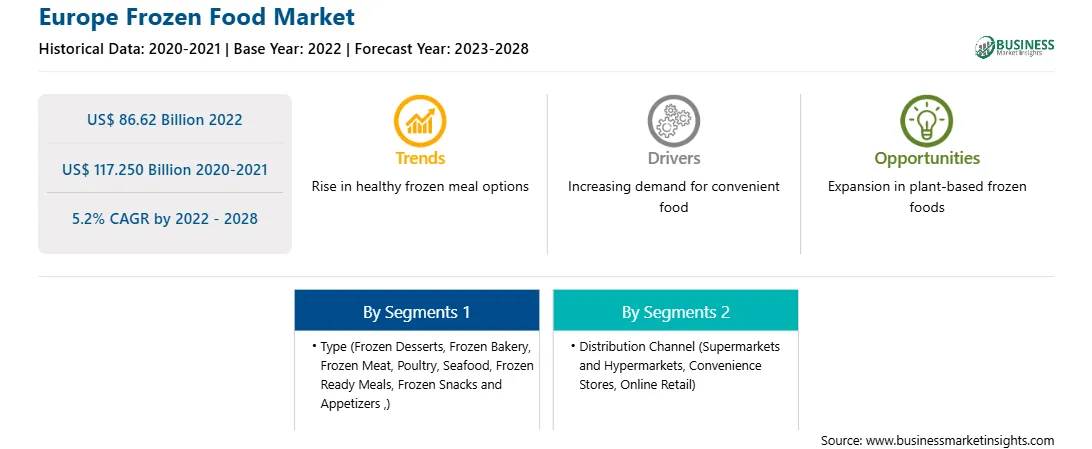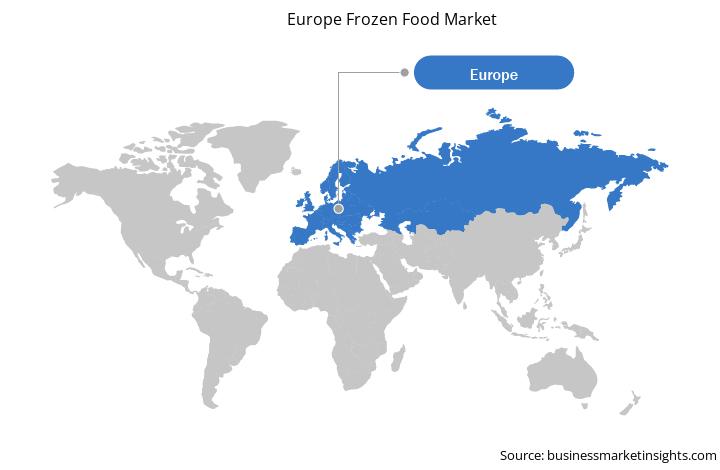The frozen food market in Europe is expected to grow from US$ 86.62 billion in 2022 to US$ 117.250 billion by 2028; it is estimated to grow at a CAGR of 5.2% from 2022 to 2028.
Rise in e-commerce is the major factor driving the growth of the Europe frozen food market. n recent years, there has been a massive transformation in the organized retail sector in many countries in the region. E-commerce has led to considerable changes in the way people shop and spend their money. The increasing penetration of smartphones and the internet, easy access to emerging technologies, a surge in purchasing power, and convenience provided by online retail platforms (in terms of shopping from anywhere at any time) are among the key factors bolstering e-commerce. Further, people are increasingly preferring online retail platforms for purchasing frozen foods. The online sales of food and beverages rose significantly during the COVID-19 pandemic due to the shutdown of brick-and-mortar stores and the imposition of social restrictions by governments. As people’s movement was constrained by lockdowns and they were compelled to work from their homes, there was a substantial shift to online shopping. Moreover, attractive discounts, wide availability of different brands on a single platform, and home delivery options drive consumers’ focus toward online shopping. With this, manufacturers of frozen foods, including Kellogg's Company and Conagra Brands, have begun enlarging their online presence by selling their products through well-known e-commerce platforms, such as Amazon.com, Lidl, and Walmart.
Europe Frozen Food
Market Revenue and Forecast to 2028 (US$ Billion)
Strategic insights for the Europe Frozen Food provides data-driven analysis of the industry landscape, including current trends, key players, and regional nuances. These insights offer actionable recommendations, enabling readers to differentiate themselves from competitors by identifying untapped segments or developing unique value propositions. Leveraging data analytics, these insights help industry players anticipate the market shifts, whether investors, manufacturers, or other stakeholders. A future-oriented perspective is essential, helping stakeholders anticipate market shifts and position themselves for long-term success in this dynamic region. Ultimately, effective strategic insights empower readers to make informed decisions that drive profitability and achieve their business objectives within the market. The geographic scope of the Europe Frozen Food refers to the specific areas in which a business operates and competes. Understanding local distinctions, such as diverse consumer preferences (e.g., demand for specific plug types or battery backup durations), varying economic conditions, and regulatory environments, is crucial for tailoring strategies to specific markets. Businesses can expand their reach by identifying underserved areas or adapting their offerings to meet local demands. A clear market focus allows for more effective resource allocation, targeted marketing campaigns, and better positioning against local competitors, ultimately driving growth in those targeted areas.Europe Frozen Food Strategic Insights

Europe Frozen Food Report Scope
Report Attribute
Details
Market size in 2022
US$ 86.62 Billion
Market Size by 2028
US$ 117.250 Billion
Global CAGR (2022 - 2028)
5.2%
Historical Data
2020-2021
Forecast period
2023-2028
Segments Covered
By Type
By Distribution Channel
Regions and Countries Covered
Europe
Market leaders and key company profiles
Europe Frozen Food Regional Insights

Europe Frozen Food Market Segmentation
The Europe frozen food market is segmented on the basis of type, distribution channel, and country. Based on type, the market is segmented into frozen desserts; frozen bakery; frozen meat, poultry, and seafood; frozen ready meals; frozen snacks and appetizers; and others. The meat, poultry, and seafood segment is expected to hold the largest market share during the forecast period. Based on distribution, the Europe frozen food market is segmented into supermarkets and hypermarkets, convenience stores, online retail, and others. The online retail segment is projected to register the highest CAGR in the market due convenience associated with online buying and product delivery options. Based on country, the Europe frozen food market is segmented into Germany, France, Italy, the UK, Russia, and the Rest of Europe. The Rest of Europe held the largest market share in 2022.
Bellisio Foods, Inc.; Bonduelle Group; General Mills; Kellogg’s Company; McCain Foods Limited; Nestle S.A.; The Kraft Heinz Company; and Tyson Foods, Inc. are among the leading companies in the frozen food market in Europe.
The Europe Frozen Food Market is valued at US$ 86.62 Billion in 2022, it is projected to reach US$ 117.250 Billion by 2028.
As per our report Europe Frozen Food Market, the market size is valued at US$ 86.62 Billion in 2022, projecting it to reach US$ 117.250 Billion by 2028. This translates to a CAGR of approximately 5.2% during the forecast period.
The Europe Frozen Food Market report typically cover these key segments-
The historic period, base year, and forecast period can vary slightly depending on the specific market research report. However, for the Europe Frozen Food Market report:
The Europe Frozen Food Market is populated by several key players, each contributing to its growth and innovation. Some of the major players include:
The Europe Frozen Food Market report is valuable for diverse stakeholders, including:
Essentially, anyone involved in or considering involvement in the Europe Frozen Food Market value chain can benefit from the information contained in a comprehensive market report.